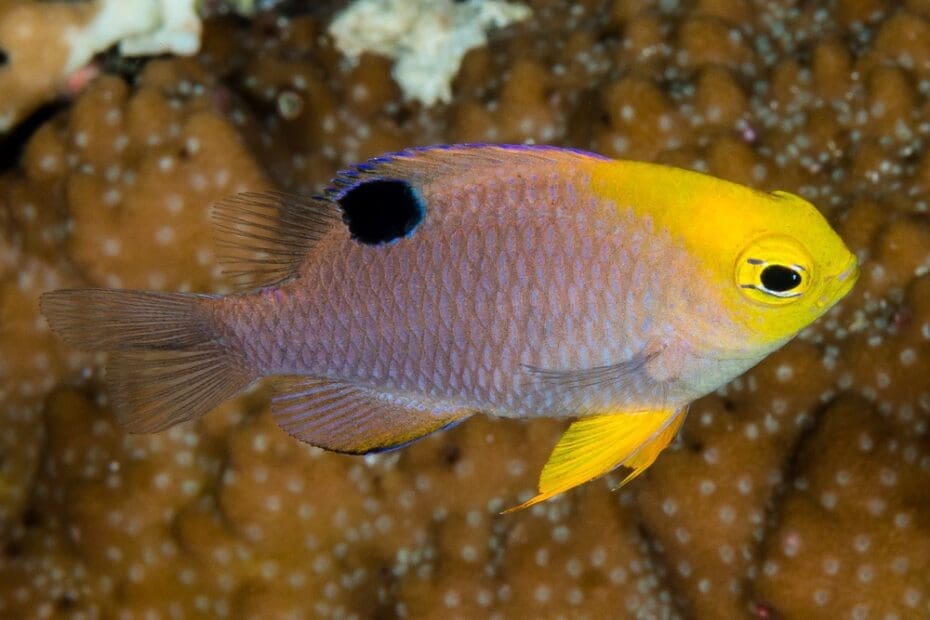Chrysiptera talboti (Talbot’s Damselfish / Talbot’s Demoiselle)
• Small fish safe: ✅ Yes
• Small invert safe: ✅ Yes
• Coral safe: ✅ Yes
• Minimum tank size: 75L+ (preferably 100L+ for groups)
• Adult size: ~6 cm (2.4 inches)
• Diet: Omnivorous (marine pellets, frozen mysis/brine shrimp, algae-based foods)
• Be aware of: Less aggressive than many other damselfish, but still defends a small territory. Juveniles are peaceful, but adults may become slightly territorial in confined spaces. Best kept singly or in groups to disperse aggression.
Talbot’s Damselfish (Chrysiptera talboti) – A Hardy and Peaceful Reef Fish
The Talbot’s Damselfish, also known as the Talbot’s Demoiselle, is a colorful and relatively peaceful species within the damselfish family. Unlike some of its more aggressive relatives, C. talboti is mild-mannered and social, making it an ideal choice for community reef tanks. Its hardy nature, striking coloration, and manageable temperament make it a great option for beginner and experienced aquarists alike.
Appearance and Coloration
Talbot’s Damselfish is easily recognizable due to its:
• Soft lavender to pale gray body, which shimmers under aquarium lighting.
• Bright yellow face and head, which gradually fades into the body.
• Distinctive black spot at the base of the dorsal fin, a signature marking.
• Compact, oval body shape, reaching up to 6 cm (2.4 inches) in length.
This gentle blend of pastel colors makes Talbot’s Damselfish a subtle yet striking addition to reef aquariums.
Natural Habitat and Behaviour
Native to the Indo-Pacific, including Indonesia, the Philippines, and the Great Barrier Reef, Talbot’s Damselfish inhabits shallow reef lagoons and coral slopes, where they:
• Swim among coral heads, using them for protection.
• Prefer sandy-bottom reef areas, where they hover just above the substrate.
• Form loose social groups, but can also be seen alone.
• Are peaceful by nature, only defending small territories when necessary.
In captivity, they maintain their calm demeanor, making them one of the best choices for a peaceful reef tank.
Tank Requirements and Water Parameters
Due to their calm but active nature, Talbot’s Damselfish require a well-structured aquarium with adequate space and hiding spots.
• Minimum tank size: 75L+ (100L+ recommended for groups or community tanks)
• Temperature: 24–27°C (75–81°F)
• pH: 8.1–8.4
• Salinity: 1.020–1.025
• Water movement: Moderate to strong
• Filtration: Good filtration and regular water changes to maintain stable water conditions.
Providing plenty of live rock and coral structures allows them to feel secure and helps reduce minor territorial disputes.
Diet and Feeding
Talbot’s Damselfish are omnivorous and require a balanced diet for vibrant coloration and overall health.
Recommended foods include:
• Frozen mysis and brine shrimp – Provides protein.
• High-quality marine pellets and flakes – Look for color-enhancing formulas.
• Algae-based foods and spirulina – Supports digestion and coloration.
• Finely chopped seafood (shrimp, squid, or fish) – Occasional protein treats.
Feed once or twice daily, ensuring a mix of protein and plant-based foods to maintain their health and coloration.
Compatibility and Tank Mates
Talbot’s Damselfish are one of the most peaceful damselfish, making them a great addition to community tanks.
✔ Peaceful and semi-aggressive tank mates, such as Clownfish, Firefish, Wrasses, and Blennies.
✔ Larger, non-aggressive fish, which can hold their own in community setups.
✔ Reef-safe invertebrates, including shrimp, snails, and crabs.
Avoid housing with:
❌ Highly aggressive fish, such as large Dottybacks or aggressive Triggerfish.
❌ Overly dominant damselfish species, which may intimidate them.
❌ Very small, delicate fish, which may be outcompeted for food.
⚠ If keeping multiple Talbot’s Damselfish, introduce them as a group to reduce territorial behavior.
Behavior and Social Structure
Unlike other damselfish, Talbot’s Damselfish:
• Are much more peaceful, rarely instigating aggression.
• Tend to hover near rockwork or coral, rather than darting aggressively.
• Defend a small personal space, but are not territorial bullies.
⚠ If kept in a small tank, they may become territorial. Keeping them in larger aquariums with good hiding spots helps prevent disputes.
Health and Disease Considerations
Talbot’s Damselfish are extremely hardy, but they can be vulnerable to:
• Marine Ich (Cryptocaryon irritans) – Often caused by stress or poor water quality.
• Bacterial infections – Can occur from territorial disputes or injuries.
• Nutritional deficiencies – A varied diet helps prevent color fading and immune issues.
To keep them healthy:
✔ Provide a balanced diet with a mix of protein and plant-based foods.
✔ Ensure stable water conditions with proper filtration.
✔ Quarantine new fish before introducing them to the main tank.
Lifespan and Long-Term Care
With proper care, Talbot’s Damselfish can live up to 5-6 years in captivity. Their resilient nature, mild temperament, and soft coloration make them a great addition to well-planned reef tanks.
Why Choose a Talbot’s Damselfish?
✔ One of the most peaceful damselfish, making it ideal for community tanks.
✔ Hardy and beginner-friendly, adapting well to various conditions.
✔ More social than most damselfish, making them easier to house with other fish.
✔ Completely reef-safe, with no risk to corals or invertebrates.
✔ Long lifespan, making them a great long-term addition to aquariums.
⚠ Important Considerations Before Buying a Talbot’s Damselfish:
🚫 Can become mildly territorial, but much less so than other damselfish.
🚫 Best kept in groups or singly, to minimize aggression.
🚫 Needs hiding spots, to feel secure in a community setting.
